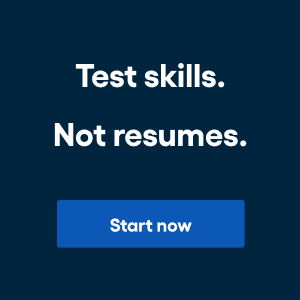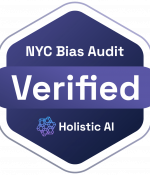Imagine this — you’re reading a job description that fits you like a glove. You’re more than qualified, have loads of experience, and it seems like a job that will actually excite you when your alarm goes off every morning. However, the job description is riddled with keywords like “digital native”, and you feel dismissed as soon as you step into the interview. You don’t get the job.
Unfortunately, this experience is common among many aging members of the workforce. Age discrimination is alive and well, regardless of the laws put in place to prevent it.
Employees can face age discrimination through subtle jokes, name-calling, themed birthday cards, and more. Older employees might be given less exciting projects and fewer opportunities for workplace advancement.
Applicants face a similar struggle. Experience levels can be capped at a certain age, job descriptions are often distributed and worded in a way that appeals to younger candidates, and resumes that stand out in the pile are often thrown out once the interview reveals the candidate’s general age range.
A lot of this is technically illegal, but age discrimination laws are not rigidly enforced. It’s up to employees to know their rights and stand up when they experience discrimination, and it’s up to employers to educate themselves on implicit bias and what could be considered discriminatory.
The best way for both parties to combat age discrimination is to stay educated and alert. In this post, we’re going through 34 age discrimination facts and ageism statistics to help hiring managers and employees alike.
Age discrimination — the basics
Two-thirds of workers 45 and older have seen or experienced age discrimination on the job. Most older Americans continue working for personal fulfillment and respect in addition to financial reasons. 16% of survey respondents report not getting the job they applied for, 12% report being passed over for a promotion, and 7% report being fired due to age discrimination. 76% of respondents say that their search for a new position could take longer than three months. 13% of older people report that they’re retired, but still working or searching for work.
Age discrimination cases account for about 20-25% of all Equal Employment Opportunity Commission (EEOC) cases. These cases receive high payouts but can be hard to prove.
Covid-19 amplified age discrimination. In fact, more than 20,000 age discrimination cases were filed in 2020.
Age discrimination law
The Age Discrimination in Employment Act (ADEA) protects workers 40 years of age and older from workplace discrimination. While this act doesn’t protect those under 40, some individual state laws do. Employers can favor older workers over younger ones. Even if both the victim and the employer are over 40, age discrimination can still take place and is illegal.
According to the U.S. Equal Employment Opportunity Commission, discrimination can occur in hiring, firing, pay, job assignments, promotions, layoffs, training, benefits, and all other conditions of employment.
Harassing a person due to their age is also illegal. This refers to any offensive or derogatory comments on age so frequent or severe that a hostile or offensive work environment is created, or if it results in an adverse employment decision such as the victim being fired or demoted. Harassers can be supervisors, coworkers, clients, and customers.
Employment policies and practices that apply to all employees can be illegal if they negatively impact applicants or employees 40 and older and are not based on a reasonable factor other than age.
The Protecting Older Workers Against Discrimination Act (POWADA) was passed by the US House of Representatives on June 23rd, 2021 to make age discrimination cases easier to prove. It currently awaits a decision by the senate. This law would reverse the 2009 supreme court decision, Gross vs. FBL Financial Services, that requires plaintiffs to show that age was the determinative reason for the discriminatory action.
Age demographics by industry
Industry and occupation data helps provide labor market estimates across industries. Those estimates are used to make funding decisions for government bodies, and help illustrate the age demographics making up the workforce across sectors.
Industries with the highest percentage of 55+ workers:
- Legal occupations 30.4%
- Management occupations 29.4%
- Building and grounds cleaning and maintenance occupations 28.6%
- Office and administrative support occupations 26.4%
Community and social service occupations 26.3%
Industries with the lowest percentage of 55+ workers:
- Food preparation and serving related occupations 13.4%
- Computer and mathematical occupations 16.8%
- Protective service occupations 19.6%
- Life, physical, and social science occupations 19.8%
- Construction and extraction occupations 19.9%
Average age by industry in 2020
- Leisure and hospitality 31.8
- Retail trade 38.3
- Education and health services 43.1
- Manufacturing 44.4
- Public administration 45.6
- National average 42.5
Facts about retirement
The current normal retirement age in the United States is 66 years of age. Nearly half of retirees say they retired earlier than expected. In 2021, 6% are retiring later than planned, 46% are retiring earlier than planned, and 48% are retiring about when planned.
A study by Neumark finds, older applicants received 68% fewer job offers than younger applicants.
Ageism– what is it and when does it start?
One study by Texas A&M economist Johanna Lahey reports a sharp drop in women’s resume ratings for candidates over 36, while male resume ratings don’t begin to drop until age 50.
Why do some people work longer?
While the average person can work until their early 70s, these numbers are lower for low education groups.
There is a clear discrepancy between the percentage of White and Black low-education workers who are capable at 62 and still capable at 67:
- White low education: Men- 74% Women 83%
- Black low education: Men- 49% Women- 62%
Waiting to claim social security until age 70 can increase monthly benefits by over 76%.
How much do people have in their savings when they retire?
According to the Federal Reserve’s Report on the Economic Well-Being of US Households in 2020, 64% of Americans aren’t sure or don’t think their savings are on track for retirement.
2019 Federal Reserve data shows that median retirement savings are $65,000, with that number expected to grow to $255,200 by retirement on average.
Medical costs for a couple over the course of retirement are estimated to be $200,000.
Median retirement account balance by age:
- 35-44: $51,000
- 45-54: $90,000
- 55-64: $120,000
Americans in their 60s have saved a median of $172,000 for retirement.
Here are the average retirement savings by age in the United States for those over 40 years old:
- Ages 40-44: $101,899.22
- Ages 45-49: $148,950.14
- Ages 50-54: $146,068.38
- Ages 55-59: $223,493.56
- Ages 60-64: $221,451.67
- Ages 65-69: $206,819.35
13 tips for combating ageism in the workplace
- Train employees on discrimination and diversity, show that your company values age diversity, and that discrimination in the workplace has consequences.
- Train employees on unconscious bias and stereotypes, including real-world examples.
- Define and enforce your anti-age discrimination policies.
- Advertise your open positions in places accessible to all ages.
- Don’t ask for a birth date, use discriminatory language in your job description, or ask age-related questions in an interview.
- Avoid stereotypes and assumptions throughout the hiring process.
- Watch out for subtle acts of discrimination (like jokes) among your employees.
- Show your employees you’re ready to listen.
- Bridge your workforce’s age gaps with mentorship programs.
- Educate yourself on the rules of retirement. You can’t ask an employee when they plan to retire.
- Even self-disparaging remarks relating to age can make employees feel discriminated against.
- Understand the difference between disparate impact and disparate treatment: Disparate treatment refers to actions that intentionally discriminate against employees. Disparate impact, however, refers to policies and practices that unintentionally discriminate against employees.
- Take a look at workforce demographics to identify the implications of possible implicit bias.
Final thoughts
It’s time to face the facts — age discrimination isn’t always intentional, but it is prevalent. Some employers turn down older candidates due to implicit bias, even if they’re older themselves.
Here’s the deal — everyone ages. At some point or another, the employer that thinks they benefit from ageism in the workplace will face that same discrimination. The consequences of age discrimination can be life-altering. People forced into early retirement might not have enough savings to survive.
As life expectancy continues to grow, this problem is going to affect more people. In fact, it’s predicted that there will be more people over 65 than under 18 by 2035. Our aging population is growing. People are living longer. The aging population is teeming with valuable experience and wisdom that we need in the workforce now more than ever.
The key to combating implicit bias and age discrimination in the workplace is education. If more people understand age discrimination statistics, 2021 could mark a new age of equal opportunity among all ages in the workforce.




















